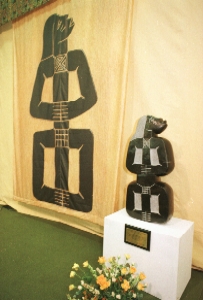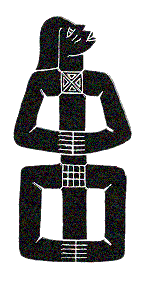By Hugh McCullum
 His graphic
designs are all over the campus. They range from the Shona stone sculpture
which has become the symbol of this assembly and the stunning backdrops in
the Great Hall and hearing rooms to the arrows pointing out the nearest padare
location.
His graphic
designs are all over the campus. They range from the Shona stone sculpture
which has become the symbol of this assembly and the stunning backdrops in
the Great Hall and hearing rooms to the arrows pointing out the nearest padare
location.
Distinctive, bold and African, there is a driving force behind all of Chaz Maviyane-Davies
work.
In his work and life, this world-renowned Zimbabwean artist displays a passion for the
human spirit as it is found in the developing world.
More of his work appeared yesterday in the foyer of the Great Hall to mark the 50th
anniversary of the Universal Declaration of Human Rights. A series of posters based on the
12 articles dramatically illustrate each fundamental human right. They are now a small
exhibition turned into posters which are available free from Amnesty International
(details below).
"Graphic designers should be message-makers as well as image-makers," he says.
"I once had a large studio and spent most of my time servicing clients. Now I work
alone for a few clients I feel share my views about life, about change and about
Africa."
His images attempt -- successfully, say Assembly organisers and participants -- to
challenge and expand barriers of culture and political expression.
"Being steeped in liberation politics and coming from a developing country has been a
driving force that has guided my direction in design and film-making," says the
feisty artist, who began his working life as a draftsman for the Rhodesian Posts and
Telecommunications Corporation.
After studying abroad and returning to Zimbabwe at independence, his work shifted
gradually but perceptibly to societal issues.
In 1992 he designed a poster for the Earth Summit at Rio de Janeiro. "The Earth
Mother" featured a nursing mother emerging from a background of dry, cracked and
painted earth. It was the most popular poster at the huge conference.
Preparing the graphics for the WCC assembly has been an immense challenge due to the
complexity of issues, the layers of bureaucracy and the decision-making process so
difficult. But the result has been a stunning success, according to Assembly organiser
Jean Stromberg.
The most powerful exhibitions of Maviyane-Davies work are the human rights posters on
display in the Great Hall. They can now, after years of frustration in distributing them,
be obtained free from Amnesty International, International Secretariat, 1 Easton Street,
London, WC1X 8DJ, UK. Mark the envelope Maviyane-Davies and send seven pounds or US12
dollars for postage.
Mementos of the Assembly art work are available as T-shirts, calendars and postcards at
the Assembly Book Store in Llewelyn Hall or Mutopos Gallery in the craft centre of the
assembly.
Back to top



His graphic designs are all over the campus. They range from the Shona stone sculpture which has become the symbol of this assembly and the stunning backdrops in the Great Hall and hearing rooms to the arrows pointing out the nearest padare location.
